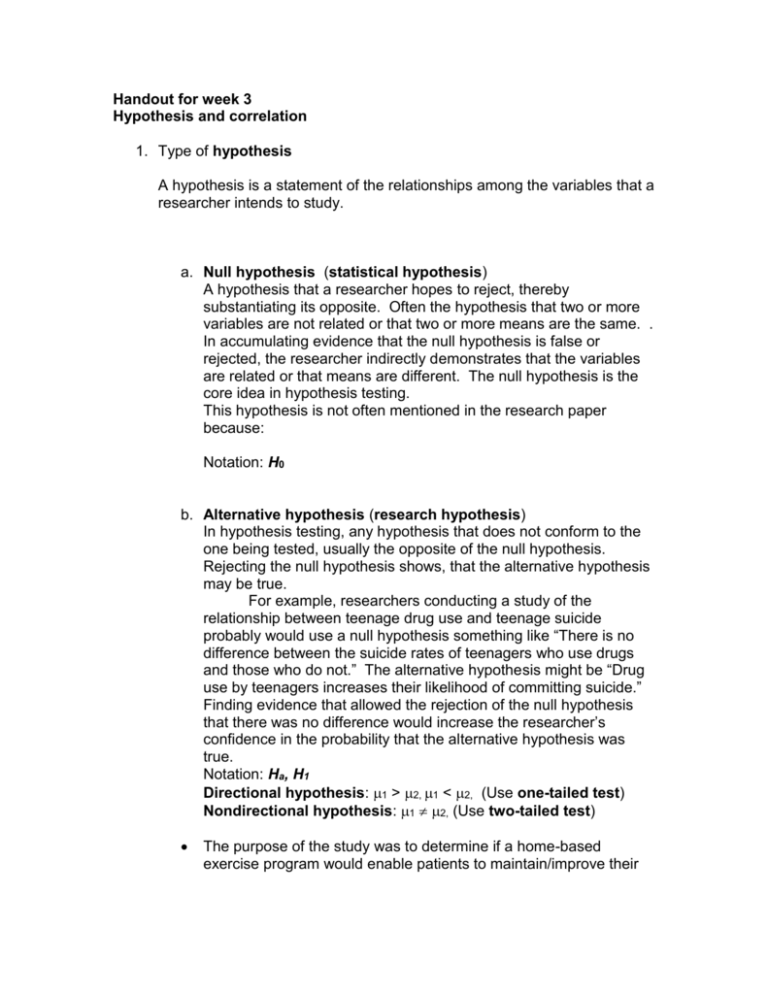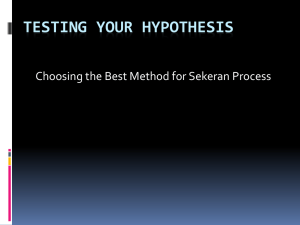Handout for week 3
advertisement

Handout for week 3 Hypothesis and correlation 1. Type of hypothesis A hypothesis is a statement of the relationships among the variables that a researcher intends to study. a. Null hypothesis (statistical hypothesis) A hypothesis that a researcher hopes to reject, thereby substantiating its opposite. Often the hypothesis that two or more variables are not related or that two or more means are the same. . In accumulating evidence that the null hypothesis is false or rejected, the researcher indirectly demonstrates that the variables are related or that means are different. The null hypothesis is the core idea in hypothesis testing. This hypothesis is not often mentioned in the research paper because: Notation: H0 b. Alternative hypothesis (research hypothesis) In hypothesis testing, any hypothesis that does not conform to the one being tested, usually the opposite of the null hypothesis. Rejecting the null hypothesis shows, that the alternative hypothesis may be true. For example, researchers conducting a study of the relationship between teenage drug use and teenage suicide probably would use a null hypothesis something like “There is no difference between the suicide rates of teenagers who use drugs and those who do not.” The alternative hypothesis might be “Drug use by teenagers increases their likelihood of committing suicide.” Finding evidence that allowed the rejection of the null hypothesis that there was no difference would increase the researcher’s confidence in the probability that the alternative hypothesis was true. Notation: Ha, H1 Directional hypothesis: 1 > 2, 1 < 2, (Use one-tailed test) Nondirectional hypothesis: 1 2, (Use two-tailed test) The purpose of the study was to determine if a home-based exercise program would enable patients to maintain/improve their blood lipids, body composition, and functional capacity after existing the cardiac rehabilitation program. State a null hypothesis. ______________________________ State a directional hypothesis. _________________________ Motor skill levels gained by children receiving therapy in a direct treatment method are different from those gained by children receiving therapy in a group/consultation treatment method. This is a ________________hypothesis. The average patient receiving a program of focused stroke rehabilitation function better than those patient who do not receive rehabilitation. This is a ____________________hypothesis. 2. Correlation Correlation is the extent to which two or more things are related (correlated) to one another. The concept of correlation is a familiar one. Paris of observations X and Y, are examined to see if they tend to “go together”. For instance, we generally accept that taller people tend to weigh more than shorter people, that children resemble their parents in intelligence, and that heart rate increases with physical exertion. Theses variables are correlated, in that changes in the values of one variable (X) are associated with changes in the other variable (Y). With a strong correlation, we can infer something about the second value by knowing the first. Correlation can be applied to paired observations on two different variables, such as heart rate and level of exertion, or to one variable measured on two occasions, such as intelligence of a parent and child. This usually is expressed as a correlation coefficient. Conventionally, the notation of X is used for an independent variable and Y, for a dependent variable. When we are strictly describing a correlational relationship between two variables, notations of X and Y are interchangeable. However, if you have reasons which variable is likely to cause the other variable, follow the conventional methods. Students often misinterpret a warning about correlations found in elementary textbooks – correlation does not equal causation. I have seen students take this warning so literally as to believe that two correlated variables cannot possibly be causally linked under any circumstances. Less erroneous, and even more widespread, is the mistaken view that a correlation between two variables provides no evidence whatsoever about cause. The evidence from correlations often is weak by experimental standards, but it is evidence – often important evidence – that would be foolish to ignore. Disciplines as diverse as economics and epidemiology are heavily based on creational evidence. Textbook warnings would be more accurate were they to read “Correlation does not necessarily equal causation.” 1. How do we interpret a correlation coefficient? A number showing the degree to which two variables are related. Correlation coefficients (often use “r”) range from –1.0 to + 1.0. If there is a perfect negative (-1.0) between A and B, then whenever A is high, B is low, and vice versa (graph 1). If there is a perfect positive correlation (+1) 0 between A and B, then whenever one is high or low, so is the other (Graph 2). A correlation coefficient of 0 means that there is no relationship between the variables (Graph 3). A zero correlation also may occur when two variables are related, but their relationship is not linear (Graph 4). Graph 1 (r= - 1) Graph 2 (r = +1) 40 30 30 20 20 10 10 0 0 -10 A A -10 0 10 20 30 40 -10 -10 B 0 10 20 30 40 B Graph 3 (r = 0) Graph 4 (r=0) 40 14 12 30 10 8 20 6 4 10 2 0 -2 B B 0 -10 A 0 10 20 30 40 -10 A 0 10 20 30 Conventionally , r = 0 - .20 r = .20 – .40 r = .40 - .60 r = .60 - .80 r = .80 – 1.00 negligible correlation low correlation medium correlation high correlation very high correlation There are numerous ways to compute correlation coefficients depending on the kinds of variables being studied. Among the most common are the Pearson correlation (parametric stat.), Spearman rank rho (nonparametric stat.), and Kendall tau (nonparametric stat.). The term correlation is used by some to refer to any measures of association and by others to refer only to the association of variables measured at an interval or ratio level. Q. Estimate the correlation coefficient for the correlation based on the graph below. Physical Disability (Y) & Pain (X) 80 60 40 20 Y 0 -20 0 10 20 30 40 50 Pain (X) 2. What is Pearson (Pearson’s) correlation? The full name is the Pearson product moment correlation coefficient and the notation is r (Do you know why the notation is r? You will find the answer in the later part of this handout.) When people say “correlation,” they are usually referring to Pearson correlation. This is a statistic that shows the degree of linear relationship between two variables that have been measured on interval or ratio scales, such as height and weight. Correlation and regression often are discussed together. This is because correlation is a special case of regression. Pearson’s r is a standardized regression coefficient (or beta) between two variables. Assignment #3 (Due 9/19) (2.5 points) 1. Using the article you chose for the assignment #1, or 2, state two hypotheses. Sometimes, they state only an aim, an object or a purpose of the study and hypotheses are not explicit. Also, some articles do not test a hypothesis but try to answer research questions. In those cases, you may have to create hypotheses for the article. Sate a null hypothesis and an alternative hypothesis. Then, find out whether the researcher rejected or accepted the null hypothesis. In usual cases, a researcher wants to reject a null hypothesis and state there is a difference between the two or more groups. If you choose a new article for this assignment, attach the article to this assignment. 2. SPSS (correlation)








